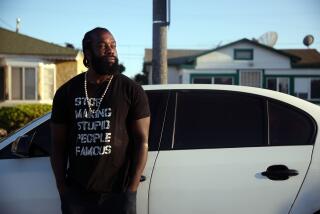In Baltimore and other cities, police have used ‘rough rides’ as payback in the past
Reporting from Baltimore — For about 44 minutes, a police wagon carrying a handcuffed Freddie Gray traveled the city’s streets. By the time it arrived at a police booking station, Gray had stopped breathing, suffering from a catastrophic spinal injury that would kill him a week later.
Now, the six officers who were involved in Gray’s death have been arrested — with the most serious charge, second-degree murder, falling on the driver of the van, Officer Caesar Goodson Jr. Prosecutors say Gray, left unsecured and shackled on his stomach on the floor of the van, suffered his “severe and critical neck injury” during the trip.
But Gray, 25, whose death has sparked riots here and protests across the country, is not the only suspect to exit a police van in far worse shape than when he went in.
In Baltimore and other cities, huge settlements have been paid to people who were put in handcuffs, then battered during what they say were intentionally wild trips, with fast turns and sudden stops that had them bouncing off metal walls and benches.
This brand of street payback, sometimes handed out when suspects ran or gave the cops a hard time, goes by different names: Here, it’s known as “the rough ride.” In Philadelphia, where it has a long and ignoble history, cops called it the “nickel ride,” a throwback to the days of 5-cent carnival tickets.
So far, no evidence has emerged that Goodson intentionally took Gray on a wild ride or did anything else to injure him; the charges are that he was negligent in not restraining him or calling for medical help.
This practice is not all that common now, according to experts in police brutality cases, but it apparently still lives.
One Baltimore woman said city police took her on a wild ride after a 2012 noise complaint at her home turned into an arrest for disorderly conduct.
“Very fast, wide turns, braking short — they were doing everything they could to make the ride as bumpy and chaotic as possible,” said Christine Abbott, a 27-year-old librarian at Johns Hopkins University who has filed a federal lawsuit against the city. The case was first reported by the Baltimore Sun.
“It was really scary,” said Abbott, who says she was handcuffed behind her back, and not belted in. “I couldn’t do anything. I was just sliding around in there.”
The officers deny taking Abbott on a rough ride, or doing anything else to harm her, according to lawyer Michael Marshall.
Dondi Johnson Sr., arrested in 2005 for urinating in public, wound up as a quadriplegic after he was “violently thrown around” in the back of a police wagon in a deliberately aggressive ride, court papers say. A jury awarded a $7.4-million verdict against the city, later reduced because of a state law capping settlements.
In Philadelphia, a man named James McKenna, who tangled with an off-duty officer in a bar, was awarded $490,000 after he suffered a broken neck in a 2011 van ride.
Before he got into the wagon, McKenna said, he heard the cop tell the driver to “f— him up.” The trip took 20 minutes to go 1.12 miles — “at 2 in the morning,” said McKenna’s lawyer, Tom Gibbons.
“Very sudden stops, very wide turns — he’s being thrown all over the van,” Gibbons said.
Ever since Gray’s April 12 arrest in a Baltimore housing project — police chased him down because he ran after catching an officer’s eye — investigators have focused on what happened to him during the ride to the station.
Cellphone videos of witnesses show officers restraining him on the ground as he yells in pain; his legs are limp as police pick him up, in handcuffs, and drag him to the waiting wagon.
The van made four stops before getting to the police booking station. After the first one, officers put leg shackles on Gray and put him back in the van, on his stomach. Department orders require prisoners to be seat-belted, said Baltimore State’s Atty. Marilyn Mosby.
It was after that first stop that Gray suffered his fatal injury, “as a result of being handcuffed, shackled by his feet and unrestrained” inside the wagon, Mosby said. At another stop, Gray said he couldn’t breathe, but officers again didn’t call for medical help, she said.
The Police Department has already conceded that Gray should have been buckled in.
The department did not respond to questions about the general practice of rough rides. However, a lawyer for the Baltimore police union, Michael Davey, said that Gray’s injuries had nothing to do with “any actions or inactions” by any of the officers.
Geoffrey Alpert, a professor at the University of South Carolina and an expert in police practices, said he used to hear it called the “screen test,” for the sudden braking that sent a back-seat suspect’s face into a metal barrier. He said the practice had proved hard to stamp out.
“It was a way to punish them without really putting your hands on them,” he said.
Indeed, the McKenna incident in Philadelphia came a decade after a 2001 investigation by the Philadelphia Inquirer documented injuries from police wagon rides to 20 people, two of whom were left paralyzed. The city paid $2.3 million in settlements but failed to discipline any of the officers, the paper found.
The practice has survived in part because it’s so difficult to prove; drivers can always claim that they had to brake suddenly because a dog ran out in front of the car, or for some other reason.
Sometimes, officers defend themselves by saying it’s too dangerous to get close enough to some prisoners to fasten a seat belt. “‘They spit on us, they head-butt us’ — that’s just an excuse,” Alpert said.
In the Johnson case, the driver of the van adamantly denied having given him a rough ride, and there was never any proof either way, according to Charles Key, a retired Baltimore police captain who testified on behalf of the family.
“The jury was concerned, though, because there was no other explanation,” Key said. “A man was arrested for public urination. When he got out of the van, he was a quadriplegic.”
Just as in the Gray case, he said that it was clear that the officer violated department policy by failing to secure the belt, he said.
Even so, Key said he knew the tales of the old days but never heard of rough rides during the years he was on the force. “It was not something that was sanctioned or even winked at,” he said. “But like every other agency or bureaucracy, you’ve got people who will do criminal things.”
Another problem has been inadequate restraint systems in some vans. In Philadelphia, some of the wagons don’t have belts at all, only a strap that runs the length of the van, at handcuff height; people are supposed to hang on, behind their backs.
“Nothing’s really perfect,” said Richard Costello, a Philadelphia police inspector who studied van safety after the McKenna case. “If you want something really secure, and God forbid a truck T-bones a van, how do you get them out?
There are no federal regulations governing the safety of prisoners in transport, according to a spokesman for the Department of Transportation, who said “those are policy decisions made by individual law enforcement agencies and private companies that transport prisoners” based on state laws.
Some departments, like that in Los Angeles, have done away with the vans altogether because of concerns about safety and design.
Alpert said there would be one easy way to end controversies and increase safety: Install cameras in the back of vans.
“If you’re watching everyone and everyone is watching you,” he said, “you certainly are going to act differently.”
Twitter: @JTanfani
More to Read
Sign up for Essential California
The most important California stories and recommendations in your inbox every morning.
You may occasionally receive promotional content from the Los Angeles Times.











